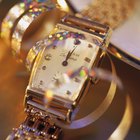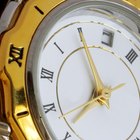The purpose of rotating watch bezels, which are often associated with scuba diving, is to keep track of elapsed time, or to make other measurements, such as average speed or distance traveled. Rotating bezels take advantage of a watch's primary function–timekeeping–to allow the wearer to keep track of something other than just the hours, minutes and seconds of the day.
Definition
A bezel is the ring that surrounds the dial, or face, of a watch. Commonly constructed of gold, gold plate or stainless steel, the bezel may be adorned with diamonds on a jewelry watch. On sports watches, it often has calibrated markings and the ability to rotate in either one or two directions. Although rotating watch bezels perform timekeeping functions, the primary purpose of the bezel is to hold the crystal covering the face of the watch in place.
Unidirectional Bezel
As the name indicates, a unidirectional bezel is one that rotates in only one direction–counterclockwise. This type of rotating bezel is often used for scuba diving. Prior to submerging, a scuba diver with 45 minutes of air in his tank could turn the bezel so either the zero mark or the 45 mark is showing, depending if it is a count-up or countdown gauge. That lets the diver know how much air is left with a quick glance at the watch, rather than subtracting the starting time from the current time to determine how many minutes have elapsed or how many minutes of air are left. The bezel on a diver's watch is often ratcheted to prevent it from accidentally being knocked out of its original position, which could be disastrous for the wearer.
Bidirectional Bezel
This type of bezel moves both clockwise and counterclockwise, enabling it to be used either for mathematical calculations or for measuring how much time has elapsed or how much time is remaining.
Tachymeter
Watches with a rotating bezel that serves as a tachymeter help the wearer calculate their speed of movement based on travel time. For example, the wearer starts the chronograph, or stopwatch function, at a mile indicator and at the next mile indicator the point on the scale where the second hand lies shows his or her miles per hour speed. It can be used with any unit of distance, as its purpose is simply to measure units traveled by hour.
Slide Rule
A slide rule bezel features logarithmic or other scales on the watch face's outer edge, enabling the wearers to perform mathematical calculations. The rotating bezel is marked with one scale and is slid around the stationary scale to make calculations of various types, which depend on the watch. Some models are designed for calculating how much fuel an airplane has used or the fuel weight.
Related Articles

How to Change to 12 Hour Time on a ...

What Is a Watch Bezel?

How to Set the Time on a Children's ...

How to Use a Tachometer on a Watch

How to Set the Time on a Rolex Daytona

Timex Expedition Indiglo Instructions

Columbia Sportswear Watch Instructions

How to Operate a Rolex GMT Master II

How to Set for 24-Hour Time on a Timex ...

How to Calibrate the Altimeter on a ...

How to Set the Alarm on a Citizen's ...

How to Stop a Timex Indiglo From ...

Casio 2747 Instructions

G Shock Watch Instructions

How to Reset the Luminox Chrono Sweep

Instructions for the Functions of an ...

Instructions for Citizen Skyhawk ...

Sector Watch Instructions

Instructions for a Seiko Perpetual

How to Set a Rolex Day-Date
References
Writer Bio
A professional writer since 1997, Ian Graham has created educational guidebooks, English as a second language learning tools and interesting facts for the Web. He graduated from the University of Victoria's Department of Writing and currently works as a reporter and photographer for a twice-weekly newspaper north of the 55th parallel.